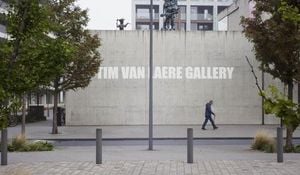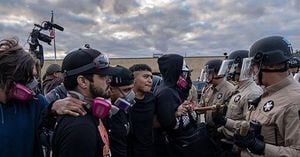In a city where politics is often unpredictable, the 2025 New York City mayoral race has taken a dramatic turn, with former President Donald Trump making an unambiguous push to shape the outcome. With the November election looming, Trump has publicly called for a winnowing of the candidate field, aiming to prevent what he sees as a historic shift toward the left under the banner of Zohran Mamdani, the Democratic nominee and self-described democratic socialist.
According to Bloomberg, Trump stated on September 5, 2025, that he wants two candidates to drop out of the race, hoping to consolidate opposition and improve the chances of defeating Mamdani. This comes amid a flurry of reports and behind-the-scenes maneuvering that have drawn in some of the city’s most prominent political figures—including current Mayor Eric Adams, former Governor Andrew Cuomo, and Republican Curtis Sliwa.
Trump’s concerns were echoed in a conversation with billionaire John Catsimatidis, who has longstanding ties to both Adams and Sliwa. As reported by the New York Post and Newsmax, Trump told Catsimatidis on August 31, 2025, that he wants long-shot candidates to exit the race by September 12, 2025. The former president, never one to mince words, reportedly said he is worried about "what might happen to the city if the Democrat candidate wins." Catsimatidis relayed Trump’s sense of urgency: "He does not want a socialist mayor, and he ... wants a person under his watch. At the end of the next 10 days, he wants the most qualified candidate to beat Mamdani. He's going to do whatever he has to do."
At the heart of the drama is Zohran Mamdani, who at just 33 years old has already upended expectations. Born in Uganda and a practicing Muslim, Mamdani labeled himself a democratic socialist and managed to clinch the Democratic primary by defeating establishment favorite Andrew Cuomo. His victory sent shockwaves through the city’s political establishment, setting up a four-way contest that few could have predicted just a year ago.
But the field is crowded. Alongside Mamdani, the ballot features former Governor Andrew Cuomo, who is running as an independent after losing the Democratic primary; Republican radio personality Curtis Sliwa; and incumbent Mayor Eric Adams, now running as an independent after a tumultuous first term. According to Bloomberg, Adams currently finds himself in fourth place—a surprising twist for the man who once presided over City Hall as a Democrat.
The intrigue deepened when reports surfaced that Trump’s advisers had been in talks with Adams about a potential job in the federal government, should Adams agree to quit the mayoral race. On September 5, 2025, The New York Times reported that Trump’s team was considering nominating Adams for the role of ambassador to Saudi Arabia, citing sources familiar with the discussions. This move, if successful, would remove Adams from the race and potentially consolidate the anti-Mamdani vote.
Adams, however, has been adamant that he is not going anywhere. In interviews and through his spokesperson, Adams denied any intention of dropping out, despite the reports of federal job offers. On September 3, 2025, he insisted, "I am not dropping my reelection campaign," addressing speculation that had been swirling after Trump administration intermediaries reached out to his allies. According to the Associated Press, these conversations were private, and it remains unclear how far they progressed before becoming public fodder.
The stakes, as Trump sees them, could not be higher. The former president has made it clear—both publicly and privately—that he views Mamdani’s possible victory as a tipping point for New York City. Trump’s push for a two-way race is rooted in the belief that a divided opposition will hand the mayoralty to Mamdani, whom he characterizes as too radical for the city. For Trump and his allies, the solution is simple: reduce the field, rally behind the strongest alternative, and keep the city from electing its first democratic socialist mayor.
Yet, the path to such a consolidation is anything but straightforward. Each remaining candidate brings a unique constituency and set of priorities. Cuomo, once the state’s most powerful Democrat, is banking on his name recognition and experience to win over centrist voters disillusioned with both the left and right. Sliwa, the Republican contender and longtime Guardian Angels leader, appeals to conservatives and those concerned about crime. Adams, for his part, is trying to chart a course as an independent, hoping to draw support from moderate Democrats and those nostalgic for his brand of pragmatic governance.
Meanwhile, Mamdani’s campaign has energized a new generation of voters, many of whom see his candidacy as a once-in-a-lifetime opportunity to remake the city’s politics. His victory in the Democratic primary over Cuomo was seen by some as a repudiation of the old guard and a signal that New Yorkers are hungry for bold change. Supporters point to his immigrant background, progressive platform, and willingness to challenge entrenched interests as evidence that he represents the city’s future.
But Mamdani’s rise has also prompted anxiety among business leaders, real estate developers, and more conservative residents, who worry about the implications of a socialist mayor in America’s largest city. Trump’s intervention, while dramatic, is not without precedent; New York’s political history is replete with high-profile figures attempting to steer races from behind the scenes. What sets this moment apart is the open acknowledgment of such efforts—and the deep divisions they expose within the city’s electorate.
The next ten days promise to be pivotal. Trump’s deadline for candidate withdrawals is fast approaching, and the pressure is mounting on Adams, Cuomo, and Sliwa to make decisions that could reshape the race. While Adams has publicly resisted calls to step aside, the possibility of a federal appointment lingers in the background, and political observers are watching closely for any signs of movement.
For now, the only certainty is uncertainty. As the campaign enters its final stretch, New Yorkers are left to ponder what kind of city they want—and who they trust to lead it. The outcome of this race will reverberate far beyond the five boroughs, offering a glimpse into the future of urban politics in a nation grappling with questions of identity, ideology, and power.
With the field unsettled and the stakes sky-high, the 2025 mayoral contest is shaping up to be one for the history books. The city waits, watching, as its political fate hangs in the balance.




